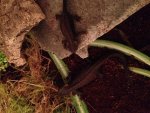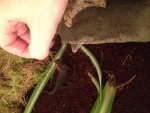Ezequiel Velasco, I feed my T. kweichownesis newts tiny crickets and black worms.
With the advice given, I remove all the sphagnum moss and placed it into my pixi frog's habitat. I was told the pixi frogs will be fine if I change it every other week. I will replace the sphagnum moss with pillow moss for my T. kweichownesis newt. Right now I just added more green moss over the fine coco fibers mix in with peat moss soil.
Is terrestrial forestry moss same as sphagnum moss?...... it look almost same but at a younger stage. Are the newts safe with forest moss? I was going to add this type of moss but wanted to check first.
I am misting the enclosure in the morning, when I get home from work, and once more before I go to bed.
I did not think of adding a dry spot but I do keep their hide hole dry. These little guys are courtesy of Ms. JenNewt (Thank You Again). Is that okay to have their hiding spot dry? I do not over water the habitat and only mist with water (dechlorified water).
I have two larger T. kweichownesis newts I picked up several years ago, the photo was taken in March of 2014. You can view them in my album. I am not sure how to add them from my album.
I have gotten lucky in caring for them and have had no problems. I feed these big guys large crickets, worms, and once a month I give them wax worm. Thank you again for the comments and advice. I will continue my research on caring for them. It is safe to say I am captivated by T. kweichownesis newts too!










